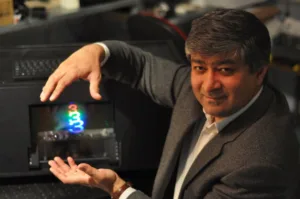Holoxica is a Scottish company which has just received €1.28 million from the European Commission’s Horizon2020 SME Instrument to develop its third generation holographic display. It will be aimed at providing volumetric display of slice-based medical images from CT, MRI and ultrasound devices.

Three years ago, we wrote about Holoxica’s second generation holographic device. This created three floating-image planes showing three sets of numbers that were imaged at different distances from the viewer (photo). The third generation device will increase the number of image planes and seek to integrate real medical image data into the display.
The motivation for this type of display is clear – there is no easy way to view all of the slice-based data in a way that is intuitive for medical professionals and patients. Today, slice-based data needs to be viewed on 2D displays one slice at a time with the medical professional doing the 3D integration in their head. Simplifying this visualization step would be a major advancement in the medical imaging field.
The holographic video projection display that Holoxica will develop leverages technologies in a number of display and related fields. For example, the system will use a DLP chip set to create the images, which will be illuminated by new narrow-band LEDs. According to Dr. Javid Khan, founder and CEO of Holoxica, these are quantum well type LEDs with FWHM bandwidths of a few nm. The generation 2 device used a laser projector but they moved to LEDs mainly for eye safety reasons.
The DLP projector produces the slice data in succession and images this onto a diffusion screen. The key innovation is the Holographic Optical Element (HOE) that is used to create the volumetric display. The HOE has a fixed focal length on the side facing the diffusion screen and multiple focal lengths on the other side. The device sweeps thru these focal lengths in synchronization with the presentation of each image slice. The result is a volume of image slices or “light sheets” that form a real, not virtual image, floating above the display device in mid-air. No glasses are needed to see this 3D image either.
The HOE contains multiple exposures of diffraction patterns to create lenses at several different focal lengths. And, these lenses must be electrically activated in sequence to the presentation of the correct image slice by the projector. That’s a pretty tall order, especially as the HOE needs to be big – about 12” square.
Khan told us in an interview that they have not fully designed the system yet – that’s what the grant is for, but he expects the system to support 1 to 10 million voxels in a cubic liter or 4”x4”x4” volume. “That’s a good size for many human organs to be visualized,” noted Khan.

While the system specs are yet to be developed, Khan expects it to be matched to the source data fidelity and frame rate. He noted that frame rates are actually quite low for these modalities at 5-15 frames per second, so there is no need to push much past this.
“We have a lot of work ahead of us including sourcing the LEDs, programming the DLP and fabricating the HOE and full system,” continued Khan. “But once done, we then plan to work with clinicians and surgeons to bring actual ultrasound, MR and CT data into the display and get their feedback on utility and viability.
Khan sees three immediate areas of utility, which the program will seek to validate. These include teaching and training using virtual cadavers facilitated by the display device; diagnostics and monitoring of medical conditions; and surgical planning.
Holoxica will carry out initial testing of the holographic video display prototype at Kings College, London; Guys and St Thomas’s Hospital, London and the Clinical Research Imaging Centre at the University of Edinburgh. Siemens Healthcare, the largest provider of medical equipment in Europe, is keen to trial the technology once it is ready for clinical use.
“We think we have disruptive technology that can service a market for medical imaging 3D display which is set to be worth an estimated $4.3 billion by 2020,” said Khan.
The latest funding from the EU was a very competitive program with thousands of submissions across the EU and only four winners from Scotland. Khan said the program is similar to the SBIR system in the US with small phase one awards, mostly for proof of principle, and larger phase 2 awards. The current award for Holoxica is in this phase 2 category.
“We are very pleased with this award, but we will need additional funds to fully commercialize this system, which is why we are also talking to VCs and strategic investors at this time to they can get in early,” said Khan.
Holoxica has just moved from Edinburgh University to CodeBase, the UK’s largest technology incubator. This will enable the company to expand and grow. Holoxica will also receive free business coaching as part of the package of support. (CC)
Contact: Kevin Dorrian, +44(0)131 661 7027, [email protected]

